Another Successful Clinical Outcome!
Admitting Diagnosis: Low Back Pain, Radiating Symptoms Down Legs, and Fecal Incontinence
Discharge Location: Home
Ms. C. is a 40-year-old female who was admitted to The Brentwood Rehabilitation and Healthcare Center from Beth Israel Deaconess Medical Center for continued skilled nursing and rehab needs following hospitalization due to low back pain, radiating symptoms down bilateral lower extremities, and fecal incontinence. Upon admission, Ms. C. was evaluated by and participated with skilled physical and occupational therapy. She was noted to require minimal assistance for bed mobility and contact guard assistance for transfers and to ambulate 40 feet with a rolling walker. She also was noted to require contact guard to minimal assistance for most self-care tasks. Ms. C. demonstrated decreased lower extremity strength, impaired balance, and impaired activity tolerance increasing her risk for falling. As she progressed with her therapy goals, she was able to participate in higher-level functional activities such as meal preparation to ensure her endurance and safety was maintained. Upon discharge, Ms. C. was able to perform bed mobility, transfer and ambulate community distances with a rolling walker and was able to ascend and descend more than 15 stairs independently. She was also able to complete all self-care tasks with supervision. She made great gains toward her therapy goals and was able to return home at an increased level of independence with home health services. Great Work, Ms. C.!
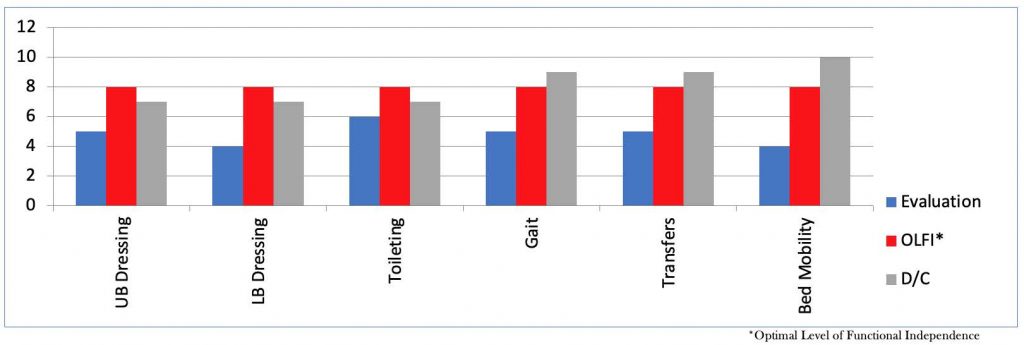
10.0 – Complete Independent – No assist, no equipment
9.0 – Modified Independent – No Assist, but equipment or extra time
8.0 – S/u – No physical assist other than set-up; supervision for safety/technique; and/or single cue to initiate
7.0 – Supervision-No physical assist; supervision for safety/technique; and/or single cue to initiate
6.0 – SBA-Pt. performs task with close supervision and or visual/verbal cues for task completion
5.0 – CGA – Contact Guard Assist
4.0 – Min – Occasional assist (25% or less time or effort to complete)
3.0 – Mod – Frequent assist (40-50% of the time or effort involved to complete task
2.0 – Max – Constant assist (75-90% of the time or effort involved to complete task
1.0 – CD – Complete Dependence: No contribution from pt; task done by others or not assessed
Another Successful Clinical Outcome!
Admitting Diagnosis: Multiple Sclerosis, Muscle Weakness, Falls
Discharge Location: Home
Mr. C. is a 63-year-old gentleman who was admitted to The Brentwood Rehabilitation and Healthcare Center with a referral from his primary care physician for continued skilled nursing and rehab needs due to inability to safely live at home, muscle weakness, and falls. Upon admission, Mr. C. was evaluated by and participated with skilled physical and occupational therapy. He was noted to require supervision for bed mobility and contact guard assistance to transfer and ambulate 20 feet with a rolling walker. He was also noted to require minimal to moderate assistance for most self-care tasks. Mr. C. demonstrated decreased strength, balance, and activity tolerance increasing his risk for falling. As he progressed with his therapy goals, he was able to participate in higher-level functional activities such as meal preparation and stair training to ensure his endurance and safety were maintained. Upon discharge, Mr. C. was able to perform bed mobility, and transfers with modified independence. He was able to ambulate 750 feet with a rolling walker and supervision and was able to ascend and descend 4 stairs with contact guard assistance. He was also able to complete all self-care tasks independently. He made great gains toward his therapy goals and was able to discharge to an assisted living facility at an increased level of independence with home health services. Great work Mr. C.!
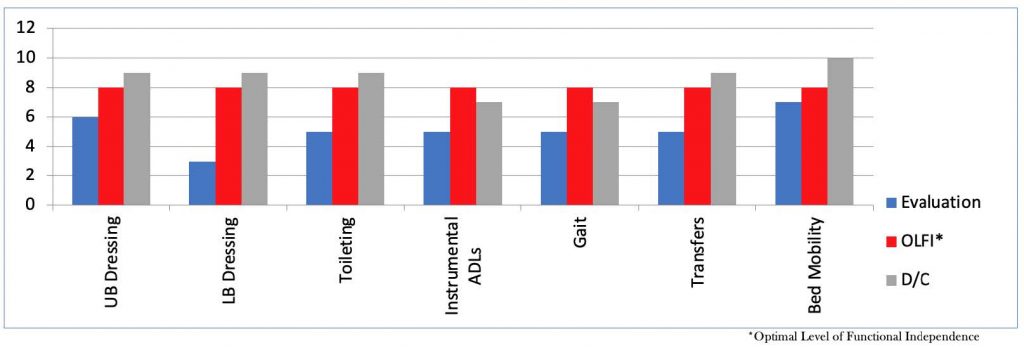
10.0 – Complete Independent – No assist, no equipment
9.0 – Modified Independent – No Assist, but equipment or extra time
8.0 – S/u – No physical assist other than set-up; supervision for safety/technique; and/or single cue to initiate
7.0 – Supervision-No physical assist; supervision for safety/technique; and/or single cue to initiate
6.0 – SBA-Pt. performs task with close supervision and or visual/verbal cues for task completion
5.0 – CGA – Contact Guard Assist
4.0 – Min – Occasional assist (25% or less time or effort to complete)
3.0 – Mod – Frequent assist (40-50% of the time or effort involved to complete task
2.0 – Max – Constant assist (75-90% of the time or effort involved to complete task
1.0 – CD – Complete Dependence: No contribution from pt; task done by others or not assessed
Another Successful Clinical Outcome!
Admitting Diagnosis: Spinal Stenosis, Lumbar Region with Neurogenic Claudication
Discharge Location: Home
Mr. A. is a 47-year-old male who was admitted to The Brentwood Rehabilitation and Nursing Center from Massachusetts General Hospital for continued skilled nursing and rehab needs. Upon admission, he was evaluated by skilled physical and occupational therapy where he was noted to require maximum assistance for bed mobility and was unable to transfer and ambulate. He was also noted to require maximum assistance with bathing and upper body dressing and was unable to perform toileting and lower body dressing tasks. Mr. A. participated in skilled physical and occupational therapy 5 times per week in addition to weekly interdisciplinary rounds to help him achieve his highest functional level. As he progressed with his therapy goals, he was able to participate in higher-level functional activities. Upon discharge, Mr. A. was able to perform bed mobility independently, transfer with modified independence, ambulate 300 feet with a rolling walker and ascend 15 stairs with supervision. He was also able to complete most self-care tasks with modified independence. Mr. A. worked hard, made great gains, and was able to return home at an increased level of independence with strong family support and home health services. Great work Mr. A.!
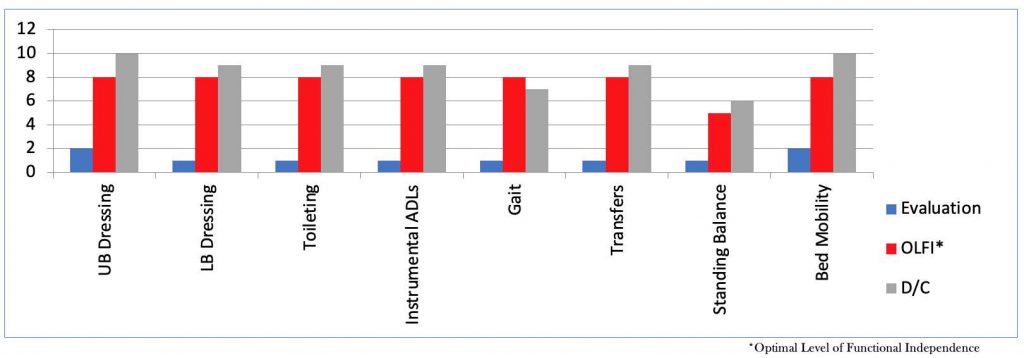
10.0 – Complete Independent – No assist, no equipment
9.0 – Modified Independent – No Assist, but equipment or extra time
8.0 – S/u – No physical assist other than set-up; supervision for safety/technique; and/or single cue to initiate
7.0 – Supervision-No physical assist; supervision for safety/technique; and/or single cue to initiate
6.0 – SBA-Pt. performs task with close supervision and or visual/verbal cues for task completion
5.0 – CGA – Contact Guard Assist
4.0 – Min – Occasional assist (25% or less time or effort to complete)
3.0 – Mod – Frequent assist (40-50% of the time or effort involved to complete task
2.0 – Max – Constant assist (75-90% of the time or effort involved to complete task
1.0 – CD – Complete Dependence: No contribution from pt; task done by others or not assessed
Case Study
Admitting Diagnosis: Other Cerebral Infarction
Discharge Location: Home
A 69-year-old male was admitted to the hospital with altered mental status and frequent falls. He was diagnosed with an acute Cerebral Infarction, was treated, stabilized and then transferred to The Brentwood Rehabilitation and Healthcare Center. Upon admission, Mr. A. was evaluated by and participated in skilled occupational and physical therapy where he was noted to require moderate to maximum assistance with most self-care tasks, minimum assistance to perform bed mobility, moderate assistance to transfer and ambulate 5 feet and was unable to ascend/descend stairs. He worked hard throughout his stay and participated in interdisciplinary rounds and care plan meetings to facilitate the achievement of his maximum functional potential. Upon discharge he was able to perform most self-care tasks with supervision, bed mobility with modified independence, was able to transfer and ambulate 300 feet with standby assistance and ascend/descend 7 stairs with contact guard assistance. Mr. A. made great gains toward his therapy goals and was able to return home with strong family support and VNA services.
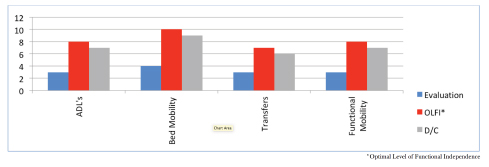
10.0 – Complete Independent – No assist, no equipment
9.0 – Modified Independent – No Assist, but equipment or extra time
8.0 – S/u – No physical assist other than set-up; supervision for safety/technique; and/or single cue to initiate
7.0 – Supervision-No physical assist; supervision for safety/technique; and/or single cue to initiate
6.0 – SBA-Pt. performs task with close supervision and or visual/verbal cues for task completion
5.0 – CGA – Contact Guard Assist
4.0 – Min – Occasional assist (25% or less time or effort to complete)
3.0 – Mod – Frequent assist (40-50% of the time or effort involved to complete task
2.0 – Max – Constant assist (75-90% of the time or effort involved to complete task
1.0 – CD – Complete Dependence: No contribution from pt; task done by others or not assessed
Case Study
Admitting Diagnosis: Other Fracture of Left Lower Leg
Discharge Location: Home
A 53-year-old male who admitted to North Shore Medical Center after tripping over his slippers and twisting his left ankle. He was diagnosed with a Left Ankle Fracture, was treated, stabilized, and then transferred to The Brentwood Rehabilitation and Healthcare Center. Upon admission, Mr. B. was evaluated by and participated in skilled occupational and physical therapy where he was noted to require standby assistance with most self-care tasks, transferring and ambulating 30 feet with a rolling walker. He worked hard throughout his stay and participated in interdisciplinary rounds and care plan meetings to facilitate the achievement of his maximum functional potential. Upon discharge, he was able to perform most self-care tasks independently, was able to transfer and ambulate 100 feet with modified independence and a single point cane, and was able to ascend/descend 15 stairs with supervision. Mr. B. made great gains toward his therapy goals and was able to return home at an increased level of independence with strong family support and VNA services.

10.0 – Complete Independent – No assist, no equipment
9.0 – Modified Independent – No Assist, but equipment or extra time
8.0 – S/u – No physical assist other than set-up; supervision for safety/technique; and/or single cue to initiate
7.0 – Supervision-No physical assist; supervision for safety/technique; and/or single cue to initiate
6.0 – SBA-Pt. performs task with close supervision and or visual/verbal cues for task completion
5.0 – CGA – Contact Guard Assist
4.0 – Min – Occasional assist (25% or less time or effort to complete)
3.0 – Mod – Frequent assist (40-50% of the time or effort involved to complete task
2.0 – Max – Constant assist (75-90% of the time or effort involved to complete task
1.0 – CD – Complete Dependence: No contribution from pt; task done by others or not assessed



